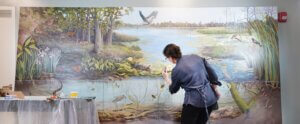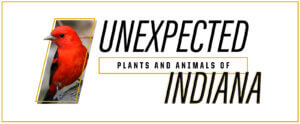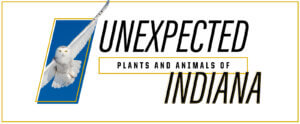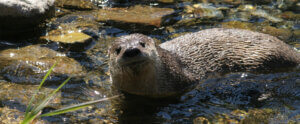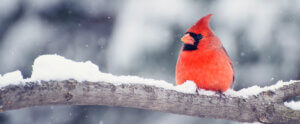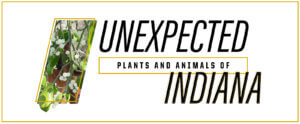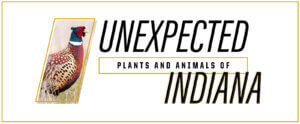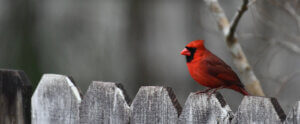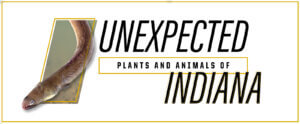Site Archive
The assignment for Purdue Natural Resources and Environmental Sciences professor Laura Bowling’s last field trip of the semester, was to collect and count invertebrates in a section of Burnett’s Creek, just north of campus. Note the reaction of students (left to right) Avery Fess, Ireland Beebe and Eva Curtis when the inch-long cranefly larvae show a little more mobility than expected.
READ MOREWalking through the front doors of the new Wildlife Ecology Research Facility (WERF,) a blank white wall welcomed visitors to the newly constructed lab building. Jason Hoverman, professor of vertebrate ecology and building deputy for WERF, saw the opportunity to depict something meaningful instead.
READ MOREA Scarlet Tanager’s bright red feathers can make them look out of place among the canopies of Indiana’s forests. But when they winter near the equator, Scarlet Tanagers look right at home.
READ MOREThe lakeshore around the Indiana Dunes National Park welcomes Snowy Owls most winters, but when predicting if the birds will make their way to Tippecanoe County, experts look far north and to the past.
READ MORE“River otters were a native species to Indiana but they were extirpated from our state,” explained Patrick Zollner, professor of quantitative ecology. With fur hundreds of times denser than human hair, otters were the target of trapping and unregulated harvesting. In 1942, they were officially classified as extinct from Indiana.
READ MOREThe Purdue Landscape Report team has received the Purdue Agriculture 2021 TEAM Award. An acronym for Together Everyone Achieves More, the college created the award in 1995 to recognize interdisciplinary team achievements of faculty and staff.
READ MOREWhat is green, popular around Christmas and steals things from trees? Other than the Grinch?
While the Grinch lives on top of a mountain, American mistletoe (Phoradendron leucarpum) lives high up on the branches of trees. Its genus, Phoradendron, translates to “tree thief” referencing its hemiparasitic nature.
READ MOREIn 1962’s “The Annotated Mother Goose,” author William S. Baring-Gould theorized the five golden rings included in “The 12 Days of Christmas” refer not to jewelry, but Ring-necked Pheasants. Whether his theory matches the English Christmas carol’s original meaning or not, pheasants have secured their place in the holiday season for families across rural America.
READ MORE“What I love about my work is I get to interact with people from all different lifestyles, livelihoods and cultures,” said Brooke McWherter, a Ph.D. candidate in forestry and natural resources. “As much as I produce knowledge, I’m learning much more.”
READ MOREIn September, the College of Agriculture announced 10 faculty members who will serve as Innovation and Entrepreneurship Ambassadors. Their role is to encourage and guide members of the college interested in taking their research and innovations out of the laboratory and into the marketplace.
READ MOREClose to finishing his biology degree at the University of Michigan, Tomas Höök decided to sign up for an ecology class.
Twenty-five years later, lessons from that semester continue to apply to the lifework of the recipient of the 2021 Agricultural Research Award, the highest honor for mid-career faculty members in the Purdue University College of Agriculture.
READ MORESimple and complex are antonyms, but not with jellyfish.
Jellyfish lack brains, bones, hearts and lungs. More than 95% of their bodies are water. Early scientists debated whether jellyfish were even animals, commonly labeling them “zoophytes,” intermediaries between animals and plants.
Jellyfish meet biology’s modern criteria for classification as animals, yet are not fish despite their name. Their lack of backbones makes them members of the phylum Cnidaria, which includes coral and sea anemones.
READ MOREIn early August, the Indiana Department of Natural Resources announced residents in 76 countries around the state could safely return their birdfeeders and baths to their yards. Earlier in the summer, DNR advised residents in all counties to remove them due to a mystery illness causing fatalities in the state’s songbird population. Since Experts and state officials did not know what the disease was or how it was spread, this was recommended as a precautionary measure.
Months after the initial announcement regarding songbird deaths, the DNR, ornithologists and wildlife researchers still don’t know the source of this illness. Residents of Allen, Carroll, Clark, Floyd, Hamilton, Hancock, Hendricks, Johnson, Lake, Marion, Monroe, Morgan, Porter, St. Joseph, Tippecanoe and Whitley counties have all been instructed to keep feeders down until further notice.
Sometimes nature mirrors society in eerie in unexpected ways. That is happening now with Indiana’s songbird populations, which are suffering from a yet unidentified illness.
Indiana’s Department of Natural Resources (DNR) and experts like forestry and natural resources professor Barny Dunning advise these precautions to slow the spread of this illness. This includes taking down birdfeeders, birdbaths and any other man-made devices for attracting birds.
Many people are involved in the remarkable range of programs, services and facilities that undergird research in the College of Agriculture. Collectively they’re integral to the college fulfilling its research mission. “Behind the Research” explores their individual roles. Each academic year, we profile six people whose work supports the College of Agriculture’s global reputation for developing innovative, multidisciplinary solutions to challenges and then putting those solutions into action.
READ MOREFrom 1935 to 1939, President Franklin D. Roosevelt’s Farm Securities Administration purchased more than 30,000 acres of land in southern Indiana under a program seeking to find land under cultivation that was susceptible to erosion, purchase the land and return it to its proper forest coverage.
READ MOREThe lives of Indiana’s American eels start and usually end more than 1,000 miles away in the saltwater of the Atlantic Ocean. The eels may journey as far north as Iceland or as far south as Venezuela. With such a wide variety of habitats, an American eel rarely feels like a fish out of water. Even when they are traveling out of the water.
READ MORE
